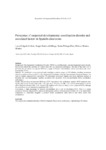Mostrar o rexistro simple do ítem
Prevalence of suspected developmental coordination disorder and associated factors in Spanish classrooms
| dc.contributor.author | Delgado-Lobete, Laura | |
| dc.contributor.author | Santos-del-Riego, Sergio | |
| dc.contributor.author | Pértega-Díaz, Sonia | |
| dc.contributor.author | Montes-Montes, Rebeca | |
| dc.date.accessioned | 2019-01-30T08:40:25Z | |
| dc.date.issued | 2019-01-15 | |
| dc.identifier.citation | Delgado-Lobete L, Santos-Del-Riego S, Pértega-Díaz S, Montes-Montes R. Prevalence of suspected developmental coordination disorder and associated factors in Spanish classrooms. Res Dev Disabil. 2019 Mar;86:31-40. | es_ES |
| dc.identifier.issn | 0891-4222 | |
| dc.identifier.uri | http://hdl.handle.net/2183/21633 | |
| dc.description.abstract | [Abstract] BACKGROUND: Developmental Coordination Disorder (DCD) is a multifactorial, neurodevelopmental motor disorder that severely affects the activities of a child's daily life and classroom performance. The aim of this study was to determine the prevalence of suspected DCD in a sample of Spanish schoolchildren and its association with socio-demographic factors. METHODS: We conducted a cross-sectional study including a random sample of 460 children attending mainstream schools in northwest Spain in 2017. A Developmental Coordination Disorder Questionnaire-European Spanish was used to evaluate suspected DCD prevalence. We performed multivariate logistic and linear regression analysis to determine the socio-demographic variables associated with suspected DCD and problematic motor coordination performance. RESULTS: The prevalence of suspected DCD was 12.2%. According to the multivariate analysis, DCD symptoms were significantly associated with males (OR = 3.0), ages above 10 years old (OR = 5.0) and low participation in out-of-school physical activities (OR = 2.3). Preterm birth children were twice as likely to show suspected DCD, although this association was not statistically significant (OR = 2.1). CONCLUSIONS: A high percentage of Spanish schoolchildren are at risk for developing DCD. There is a strong connection between suspected DCD and socio-demographic factors. Protocols aimed to detect DCD and intervention programmes in classrooms designed to promote motor coordination skills need to take these factors into consideration. | es_ES |
| dc.language.iso | eng | es_ES |
| dc.publisher | Elsevier | es_ES |
| dc.relation.uri | https://doi.org/10.1016/j.ridd.2019.01.004 | es_ES |
| dc.rights | Creative Commons Attribution-NonCommercial-NoDerivatives 4.0 International License (CC-BY-NC-ND 4.0) | es_ES |
| dc.rights.uri | http://creativecommons.org/licenses/by-nc-nd/4.0 | * |
| dc.subject | Developmental coordination disorder | es_ES |
| dc.subject | Child development | es_ES |
| dc.subject | Psychomotor performance | es_ES |
| dc.subject | Epidemiology | es_ES |
| dc.subject | Prevalence | es_ES |
| dc.title | Prevalence of suspected developmental coordination disorder and associated factors in Spanish classrooms | es_ES |
| dc.type | info:eu-repo/semantics/article | es_ES |
| dc.rights.access | info:eu-repo/semantics/embargoedAccess | es_ES |
| dc.date.embargoEndDate | 2021-02-15 | es_ES |
| dc.date.embargoLift | 2021-02-15 | |
| UDC.journalTitle | Research in Developmental Disabilities | es_ES |
| UDC.volume | 86 | es_ES |
| UDC.startPage | 31 | es_ES |
| UDC.endPage | 40 | es_ES |






